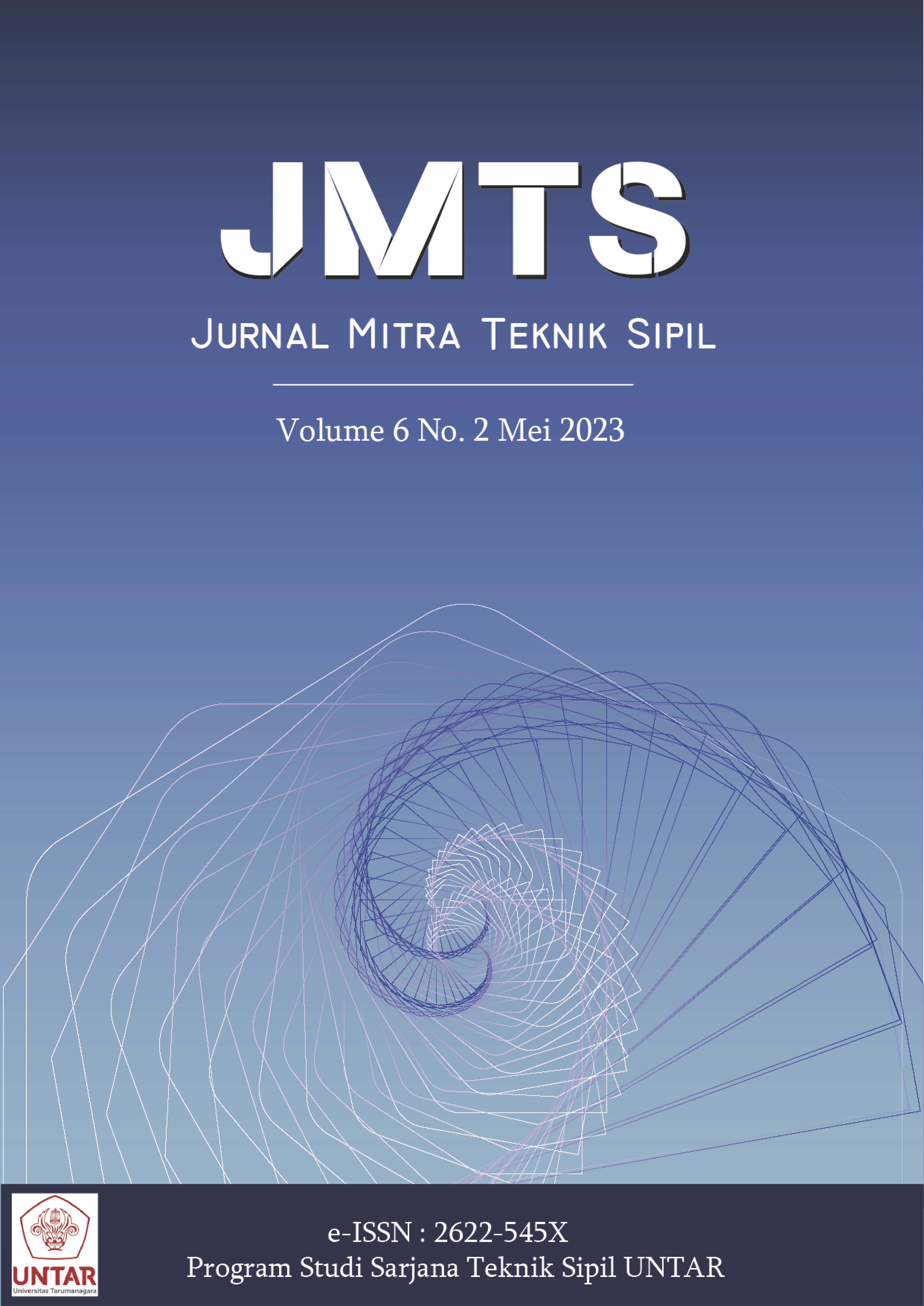SIFAT MEKANIS BETON RINGAN DENGAN STYROFOAM SEBAGAI MEDIA PEMBENTUK UDARA
Main Article Content
Abstract
Concrete is one of the most used materials in construction. Due to the weight of the concrete is quite heavy, lightweight concrete is invented. One method for making lightweight concrete is to fill or blow air in the mortar. One of the components that can be utilized in this method is by adding styrofoam to the concrete mixture. Because styrofoam doesn't interact with or react during the hydration process between cement and water, styrofoam can be utilized as a filler material and the concrete will be lighter if air is added to the mixture by using styrofoam as the medium. Compressive strength, elastic modulus, flexural strength, and split tensile strength tests were performed in this study. The number of samples made was 6 cylindrical pieces and 3 beam-shaped pieces for each concrete variation. Types of variations in the percentage of styrofoam in this study were 0%, 50%, 60%, and 70%. The treatment of the test object is done by immersion. The values of split tensile strength, compressive strength, modulus of elasticity, and flexural strength will decrease when the volume of styrofoam in the concrete mixture increases due to pore volume increase.
Abstrak
Beton adalah sebuah bahan atau material yang umum digunakan dalam konstruksi bangunan. Karena massa beton yang cukup berat, maka teknologi beton ringan ditemukan. Pembuatan beton ringan dapat dibuat dengan metode pengisian atau peniupan udara ke dalam adukan atau mortar. Pembuatan beton ringan dengan metode ini dapat dilakukan dengan menambahkan material styrofoam ke dalam campuran beton. Styrofoam dapat digunakan sebagai material pengisi (filler), karena styrofoam tidak mengganggu atau tidak ikut bereaksi pada proses hidrasi antara semen dan air. Penggunaan styrofoam sebagai media untuk memasukkan udara ke dalam campuran beton akan menghasilkan beton yang lebih ringan. Pengujian yang dilakukan dalam penelitian ini adalah kuat tarik belah, kuat lentur, kuat tekan, serta modulus elastisitas. Sampel dibuat sebanyak 6 buah berbentuk silinder dan 3 buah berbentuk balok untuk setiap variasi beton ringan styrofoam. Jenis variasi persentase styrofoam yang diuji pada penelitian ini adalah 0%, 50%, 60%, dan 70%. Proses curing benda uji dilakukan dengan metode perendaman. Nilai modulus elastisitas, kuat tekan, kuat tarik belah, dan kuat lentur akan menurun pada saat persentase styrofoam dalam campuran beton bertambah yang diakibatkan oleh kenaikan volume pori dalam beton.
Article Details

This work is licensed under a Creative Commons Attribution-NonCommercial-ShareAlike 4.0 International License.
This work is licensed under Jurnal Mitra Teknik Sipil (JMTS) Creative Commons Attribution-ShareAlike 4.0 International License.References
Badan Standardisasi Nasional. (2019). SNI 2847:2019 tentang Persyaratan Beton Struktural Untuk Bangunan Gedung dan Penjelasan. Jakarta: Badan Standardisasi Nasional.
Departemen Pekerjaan Umum. (2002). SNI 03-3449-2002 Tata Cara Rencana Pembuatan Campuran Beton Ringan dengan Agregat Ringan. Bandung: Badan Standardisasi Nasional.
Dobrowolski, J. A. (1998). Concrete Construction Handbook. New York: McGraw-Hill.
Hadi, S. (2019). Analisis Kuat Tekan Beton Ringan dengan Bahan Tambah Styrofoam. Media Bina Ilmiah, 14(5), 2533-2540.
Karolina, R., Simanjuntak, R., Syahrizal, & Handana, A. P. (2018). The Effect of Polystyrene on Concrete Mechanical Properties. ACEIVE 2018: Proceedings of the 2nd Annual Conference of Engineering and Implementation on Vocational Education (ACEIVE 2018) (p. 356). North Sumatra: European Alliance for Innovation.
Kushartomo, W., Makarim, C. A., Supartono, F. X., & Sumawiganda, S. (2013). Pengaruh Penambahan Quartz Powder pada Reactive Powder Concrete terhadap Terbentuknya Kalsium-Silikat-Hidrat. Jurnal Teknik Sipil ITB, 20(3), 187-194.
Purnawirati, I. N. (2020). Pengaruh Faktor Air Semen Terhadap Sifat Mekanis Beton Ringan Styrofoam. Jurnal Kacapuri: Jurnal Keilmuan Teknik Sipil, 3(2), 59-70.
Sadrmomtazi, A., Sobhani, J., Mirgozar, M. A., & Najimi, M. (2012). Properties of Multi-strength Grade EPS Concrete Containing Silica Fume and Rice Husk Ash. Construction and Building Materials, 35, 211-219.
Short, A., & Kinniburgh, W. (1978). Lightweight Concrete. London: Applied Science Publishers.
Solikin, M., Widiyanto, R., Asroni, A., Setiawan, B., & Asnan, M. N. (2019). High Content Styrofoam as Partial Subtitution for Fine Aggregate in SCC Lightweight Concrete Brick. AIP Conference Proceedings (p. 030022). AIP Publishing LLC.
Sutandi, A., & Kushartomo, W. (2019). Pengaruh Ukuran Butiran Maksimum Terhadap Kuat Tekan Reactive Powder Concrete. Jurnal Muara Sains, Teknologi, Kedokteran, dan Ilmu Kesehatan, 161-170.
Tjokrodimuljo, K. (2007). Teknologi Beton. Yogyakarta: Biro Penerbit Teknik Sipil Universitas Gadjah Mada.
Wulandari, M., Sofianto, M. F., & Tavio. (2020). Split Tensile and Flexural Strength of Concrete with Artificial Lightweight Aggregate (ALWA) and Steel-fiber. Journal of Physics: Conference Series, 1569(4), 042025.
Yunanto, A. D., Gunawan, P., & Sunarmasto, S. (2014). Studi Kuat Tekan, Kuat Tarik Belah, dan Modulus Elastisitas Beton Ringan Teknologi Foam dengan Bahan Tambah Serat Polyester. Matriks Teknik Sipil, 2(4), 619-627.



